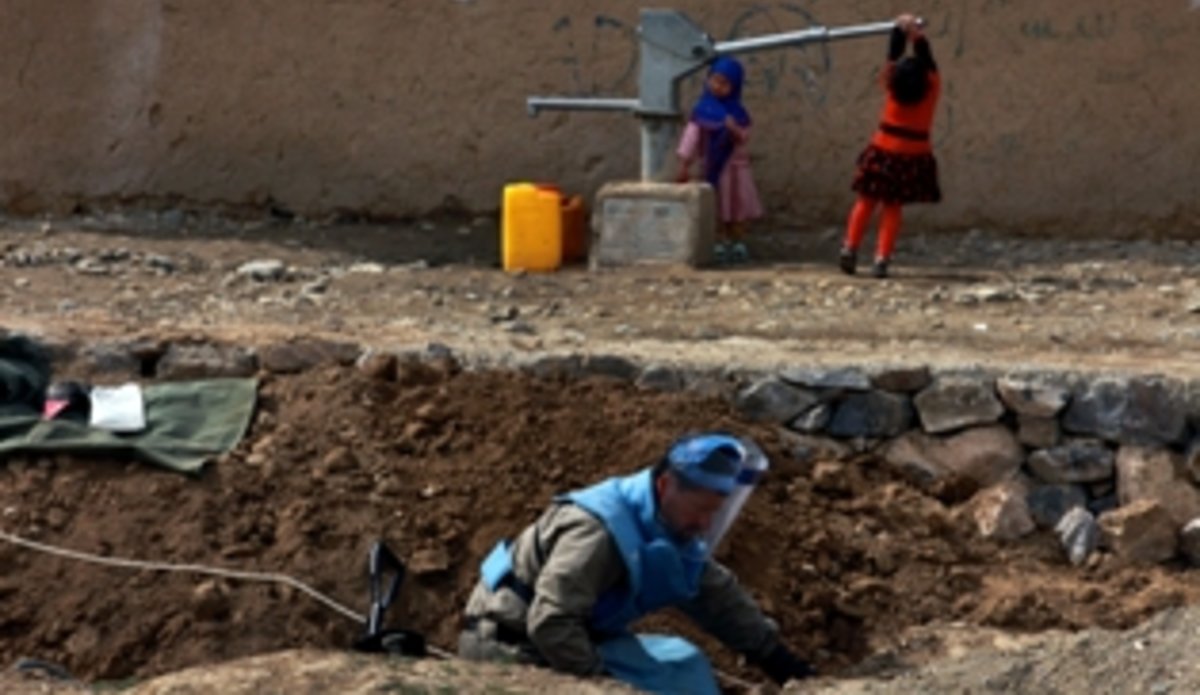Afghanistan To Be Mine-Impact Free in 10 Years
KABUL - After decades of sustained clearance efforts, Afghanistan is within 10 years of becoming free from the impact of mines. Working closely with the Afghan Government, the Mine Action Programme of Afghanistan (MAPA) has developed an action plan to remove all known hazards within a decade.
The plan is part of the Government’s request to the Secretariat of the Ottawa Convention to extend until 2023 Afghanistan’s deadline to clear its territory of all anti-personnel mines.
The Ottawa Convention is known as the “Convention on the Prohibition of the Use, Stockpiling, Production and Transfer of Anti-Personnel Mines and on their Destruction”. As of January 2012, 159 states had acceded to the Convention, with Afghanistan becoming a State Party in 2003. Under Article 5 of the Convention, countries are obligated to remove all anti personnel mines from mined areas within ten years of their becoming a State Party.
“Had the war not continued, and had we had sufficient funding, we would have resolved this problem by now,” said Mohammad Sediq Rashid, Chief of Operations for the Mine Action Coordination Centre of Afghanistan (MACCA), which coordinates MAPA implementation.
And as economic enterprise develops across Afghanistan, MAPA is finding previously unknown minefields laid during past conflicts, which has also pushed back the original timeline for clearance.
Mr. Rashid noted that the extension request and action plan include the clearance of anti-tank mines and other explosive remnants of war. “These have a great impact on the population. So, from a humanitarian perspective, Afghanistan cannot focus solely on the eradication of anti-personnel mines.”
The magnitude of the mine problem in Afghanistan, coupled with ongoing conflict, under-funding and poor records of mined areas, have meant that the initial deadline of 2013 was untenable. In March 2012, the Afghan Government submitted the request for a ten-year extension, which will be assessed by 10 members of Secretariat by the end of November 2012.
“It is very important for Afghanistan to stay committed to the Convention and its targets,” said Mr. Rashid. “This could also have implications for international funding for mine action and other assistance from State Parties.”
In the last two decades of operations, MAPA – the collective term for all agencies involved in demining efforts in Afghanistan – has made tremendous progress, clearing vast swaths of lands around the country. However, much remains to be done.
Over a million Afghans still live within 500 meters of landmine contaminated areas, and nearly 6,000 mine-contaminated sites exist in 33 out of Afghanistan’s 34 provinces. Only DaiKundi province is mine-free.
Located in rangelands as well as adjacent to important pieces of infrastructure, the remaining mine-affected areas are a significant drag on development. According to MACCA, 17 provinces each contain over 100 contaminated sites, located near irrigation systems, power supply lines and the ring road. Large scale development projects such as the planned railway between Kabul and Mazar and hydro-electric dam projects in Kunar, Laghman and Takhar provinces are often constrained by the presence of minefields. Presently there are 43 development projects which will require some mine action intervention.
“Mine action inventions are undertaken based on a system of prioritization. Top priority is given to roads, residential and business areas, irrigation systems and agricultural lands,” said Mr. Rashid. “Currently 80 percent of the mine-contaminated sites are in the agricultural and rangelands.”
For the year 1391 (2012-1013), 38 projects have been planned by the MAPA. The demining teams will work in 493 villages in 107 districts throughout 24 provinces. As a result of these efforts, 30 districts will be cleared of mines and other explosive devices.
Large scale mine clearance operations began in Afghanistan after the withdrawal of Soviet forces in 1989. Over the past 23 years, 1,914 communities have been cleared of mines. Demining teams have cleared or canceled 19,088 sites over 1,939 kilometers and defused over one million anti personnel mines. (The term ‘canceling’ a minefield refers to a process whereby a suspected hazardous area is verified to be free of mines.) This also includes the destruction of stockpiles belonging to the Afghan Ministry of Defense, which was a requirement of the Ottawa Convention. To date, around 35,000 anti-tank mines and 14.8 million other explosives have been destroyed.
An essential component of the mine clearance programme is risk awareness training for residents living in areas blighted by mines and unexploded ordnance. In the past decade, nearly 12.5 million Afghans have received mine risk education.
MACCA’s Chief of Operations said that MAPA’s efforts have largely eliminated mines from Afghanistan’s major cities. The clearance work also enabled the completion of several power lines, including a supply line from Uzbekistan to Kabul. Casualty rates have plummeted.
“The demining work has significantly contributed to reducing the casualty rates from mines from 2,027 in 2001 to 391 in 2011. That is having a direct impact on the socio-economic uplift of the Afghan people and economy,” said Mr. Rashid.
 UN
UN






